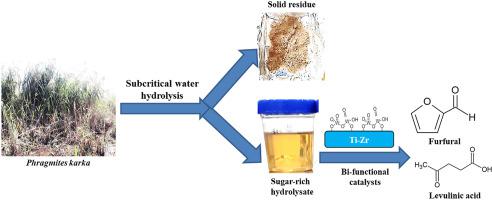Biomass & Bioenergy ( IF 5.8 ) Pub Date : 2021-01-11 , DOI: 10.1016/j.biombioe.2021.105965 Falguni Pattnaik , Sonil Nanda , Vivek Kumar , Satyanarayan Naik , Ajay K. Dalai

|
Phragmites karka, also known as common reed, is a perennial grass and a highly invasive crop species, which creates ecological problems by competing with native biodiversity and vegetation. This study involves subcritical water hydrolysis of Phragmites to produce monomeric sugars followed by the catalytic conversion of the sugar-rich hydrolysate to furfural and levulinic acid. Subcritical water hydrolysis was performed by the Central Composite Design method at variable temperatures (150–230 °C), reaction time (15–60 min) and feed concentration (2–5 wt%). The temperature was found to be the most prominent factor affecting biomass hydrolysis. The yield of total reducing sugars from biomass hydrolysis was in the range of 2.1–18.1% where the highest yield was obtained at the optimal temperature (190 °C), reaction time (37.5 min) and feed concentration (2 wt%). During subcritical water hydrolysis of Phragmites, two main degradation products obtained at a higher temperature (230 °C) and reaction time (37.5 min) were furfural (8.2%) and 5-hydroxymethylfurfural (11.7%). However, at 230 °C and a longer reaction time of 60 min, 5-hydroxymethylfurfural yield reduced to 5.1% owing to its conversion to humin while furfural yield elevated to 9.9%. Catalysts such as ZrO2, TiO2, Zr0.5Ti0.5O2, WO3–ZrO2, WO3–TiO2 and WO3–Zr0.5Ti0.5O2 were involved in the conversion of the sugar-rich hydrolysate obtained from subcritical water hydrolysis of Phragmites. The highest sugar conversion was found to be 92% with WO3–ZrO2 resulting in the yields of furfural (51%) and levulinic acid (34%). The activity of particular catalysts (e.g. WO3–ZrO2, WO3–TiO2 and WO3–Zr0.5Ti0.5O2) relied on the synergistic effects of Lewis and Brønsted acid sites.
中文翻译:

芦苇的亚临界水水解,用于糖提取和催化转化为平台化学品
芦苇karka,也被称为芦苇,是多年生草和高度入侵的农作物,通过与本地生物多样性和植被竞争而造成生态问题。这项研究涉及芦苇的亚临界水水解生成单体糖,然后将富含糖的水解产物催化转化为糠醛和乙酰丙酸。亚临界水水解是通过中央复合设计方法在可变温度(150–230°C),反应时间(15–60分钟)和进料浓度(2–5 wt%)下进行的。发现温度是影响生物质水解的最主要因素。生物质水解产生的总还原糖的产率在2.1-18.1%的范围内,其中在最佳温度(190°C),反应时间(37.5分钟)和进料浓度(2 wt%)时可获得最高的产率。亚临界水水解芦苇期间,在较高温度(230°C)和反应时间(37.5分钟)下获得的两种主要降解产物是糠醛(8.2%)和5-羟甲基糠醛(11.7%)。然而,在230°C和更长的60分钟反应时间下,由于5-羟甲基糠醛转化为腐殖质,其收率降至5.1%,而糠醛的收率提高至9.9%。ZrO 2,TiO 2,Zr 0.5 Ti 0.5 O 2,WO 3 -ZrO 2,WO 3 -TiO 2和WO 3 -Zr 0.5 Ti 0.5 O 2等催化剂参与了从芦苇的亚临界水水解获得的富含糖的水解产物的转化。发现WO 3 -ZrO 2的最高糖转化率为92%,导致糠醛(51%)和乙酰丙酸(34%)的产率。特定催化剂(例如,WO 3 -ZrO 2,WO 3 -TiO 2和WO 3 -Zr 0.5 Ti 0.5 O 2)的活性取决于路易斯和布朗斯台德酸位点的协同作用。











































 京公网安备 11010802027423号
京公网安备 11010802027423号